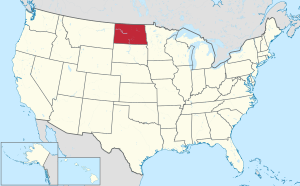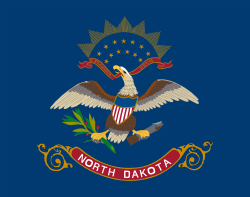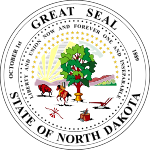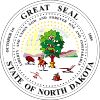North Dakota
North Dakota is a state in the United States. About 780,000 people lived in North Dakota in the year 2020. The capital and seat of government is Bismarck and the largest city is Fargo.
North Dakota | |
|---|---|
| State of North Dakota | |
| Nickname(s): Peace Garden State, Roughrider State, Flickertail State | |
| Motto(s): Liberty and Union, Now and Forever, One and Inseparable | |
| Anthem: North Dakota Hymn | |
 Map of the United States with North Dakota highlighted | |
| Country | United States |
| Before statehood | Dakota Territory |
| Admitted to the Union | November 2, 1889 (39th or 40th) |
| Capital | Bismarck |
| Largest city | Fargo |
| Largest metro and urban areas | Fargo metropolitan area |
| Government | |
| • Governor | Kelly Armstrong (R) |
| • Lieutenant Governor | Michelle Strinden (R) |
| Legislature | Legislative Assembly |
| • Upper house | Senate |
| • Lower house | House of Representatives |
| U.S. senators | John Hoeven (R) Kevin Cramer (R) |
| U.S. House delegation | Julie Fedorchak (R) (list) |
| Area | |
| • Total | 70,761 sq mi (183,843 km2) |
| • Land | 59,708 sq mi (169,571 km2) |
| • Water | 1,726 sq mi (4,435 km2) 2.4% |
| • Rank | 19th |
| Dimensions | |
| • Length | 300 mi (482 km) |
| • Width | 200 mi (321 km) |
| Elevation | 1,900 ft (580 m) |
| Highest elevation | 3,606 ft (1,069 m) |
| Lowest elevation | 864 ft (216 m) |
| Population (2019) | |
| • Total | 762,062 |
| • Rank | 47th |
| • Density | 10.73/sq mi (4.13/km2) |
| • Rank | 47th |
| • Median household income | $61,843 [3] |
| • Income rank | 19th |
| Demonym | North Dakotan |
| Language | |
| Time zones | |
| most of state | UTC−06:00 (Central) |
| • Summer (DST) | UTC−05:00 (CDT) |
| southwest | UTC−07:00 (Mountain) |
| • Summer (DST) | UTC−06:00 (MDT) |
| USPS abbreviation | ND |
| ISO 3166 code | US-ND |
| Traditional abbreviation | N.D., N.Dak., Nodak |
| Latitude | 45° 56′ N to 49° 00′ N |
| Longitude | 96° 33′ W to 104° 03′ W |
| Website | nd |
| North Dakota state symbols | |
|---|---|
 | |
 | |
| Living insignia | |
| Bird | Western meadowlark |
| Fish | Northern pike |
| Flower | Wild prairie rose |
| Grass | Western wheatgrass |
| Insect | Western honeybee |
| Mammal | Nokota horse |
| Tree | American Elm |
| Inanimate insignia | |
| Beverage | Milk |
| Dance | Square dance Line dance |
| Fossil | Teredo petrified wood |
| Other | Chokecherry (state fruit) |
| State route marker | |
 | |
| Lists of United States state symbols | |
Geography
changeNorth Dakota is south of Manitoba and Saskatchewan, east of Montana, north of South Dakota, and west of Minnesota. Manitoba and Saskatchewan are provinces - part of Canada. Montana, South Dakota, and Minnesota are other states in the United States.
Weather
changeNorth Dakota is not close to any big bodies of water (oceans or seas). Because of this, temperatures in North Dakota are very hot in the summer and very cold in the winter. In the summer, there are sometimes strong thunderstorms. These storms can have tornadoes and hail.
History
changeBefore European people came, Native American people lived in the area now called North Dakota. One important tribe was the Mandan.
North Dakota was one of the last US states to be settled by people of European ancestry. (To have people go there to make homes and live.) On November 2, 1889, North Dakota (and South Dakota) became part of the United States.
Economy
changeMost of the economy is based on agriculture. The most important agricultural crops are durum, a type of wheat, which is grown all across the state. In the Red River Valley, there is more rain, and maize (corn) and sugar beets are grown as well. In the Badlands, there is less rain, and more cattle are raised than crops.
North Dakota has the only bank in the United States that is owned by the state. The Bank of North Dakota is where all of the money from all government agencies is held. Most banks in the United States are guaranteed by the FDIC (acronym for Federal Deposit Insurance Corporation.) The FDIC guarantees that people will not lose money if a bank fails. But the Bank of North Dakota is insured by the state of North Dakota.
Related pages
changeReferences
change- ↑ 1.0 1.1 "Elevations and Distances in the United States". United States Geological Survey. 2001. Archived from the original on October 15, 2011. Retrieved October 24, 2011.
- ↑ 2.0 2.1 Elevation adjusted to North American Vertical Datum of 1988.
- ↑ "Median Annual Household Income". The Henry J. Kaiser Family Foundation. Archived from the original on December 20, 2016. Retrieved December 9, 2016.
- ↑ "North Dakota Century Code, CHAPTER 54–02–13" (PDF). September 13, 2013. Archived (PDF) from the original on January 17, 2013. Retrieved September 13, 2013.

